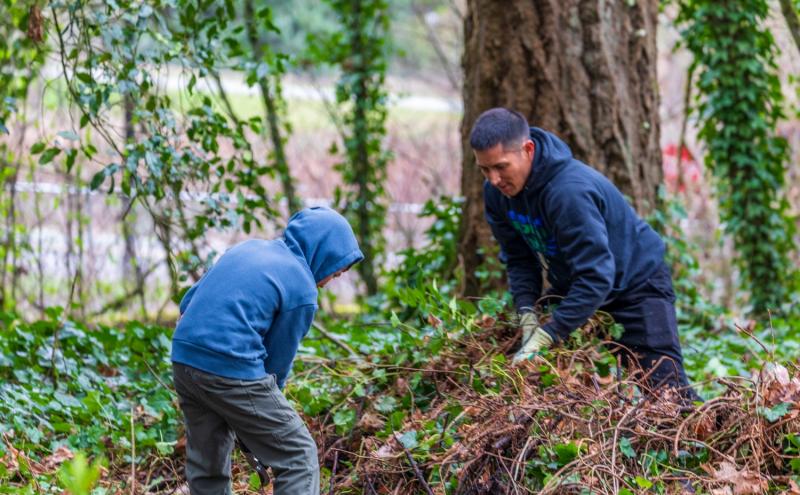
By Risa Askerooth, Port environmental management specialist
On a drizzly weekend morning in early March, community members gathered beneath the trees of an urban forest for a stewardship event hosted by Seattle-Tacoma International Airport (SEA). Fueled by hot cocoa and collective enthusiasm for restoration work, volunteers pulled invasive ivy from the trees and forest floor to ensure the health of native vegetation and prepare the site for additional planting. Not only is this work immediately satisfying (some of the ivy stems removed were almost one foot wide!), but it also has enduring benefits for forests and communities near the airport.
This occurrence is part of a series of community stewardship events involving native vegetation planting and, more recently, invasive species removal. Since the first kickoff event in 2018, these efforts have restored over three acres of urban forest, representing one of the many ways SEA continues to invest in balancing environmental and community benefits with operational safety and economic benefits. These stewardship events also further the SEA goal to be the greenest, most energy-efficient airport in North America while building upon its history of environmental stewardship.
As part of the Land Stewardship Plan, community stewardship sites are chosen strategically to ensure the greatest equity benefit by prioritizing areas along habitat corridors, census tracts with poor equity scores, and sites that expand and connect existing habitat. For instance, the most recent community event expanded the footprint of a restoration site directly adjacent to the City of SeaTac’s Des Moines Creek Park, which provides a valuable and accessible natural area.
These events also offer an opportunity for community members to directly steward the urban forests in their area, foster relationships with neighbors, and learn effective actions for environmental restoration and management. From career arborists to children planting their first tree, the work of community members will last far longer than the duration of the event and are vital for ensuring healthy forest ecosystems and resilient communities.
Although the most immediate and visible benefit of trees is perhaps aesthetic, they also play a vital role in ensuring healthy communities and ecosystems by battling climate change, improving air quality, providing habitat, and reducing urban heat island effects. In fact, recent research has illustrated these air temperature benefits on a hyper-local scale in western Washington. Similarly, invasive species threaten the health of native plants, and restoring invasive areas to a native habitat enhances existing habitat while reducing economic costs of infrastructure maintenance.
Community stewardship events happen biannually, and SEA staff and field crews, including the Washington Department of Ecology’s Washington Conservation Corps, invest significant energy annually to continue to maintain these stewardship sites. Long-term maintenance and monitoring are essential to restoration success following stewardship events, and these groups play a critical role in protecting native plantings from encroaching invasive species and other stressors.
Other Port stewardship initiatives and partnerships include the recent Commission adoption of the SEA Land Stewardship Plan and Tree Replacement Standards as well as the Duwamish Alive! event on April 20. The next community stewardship event to plant native trees and shrubs will occur in Fall 2024.








